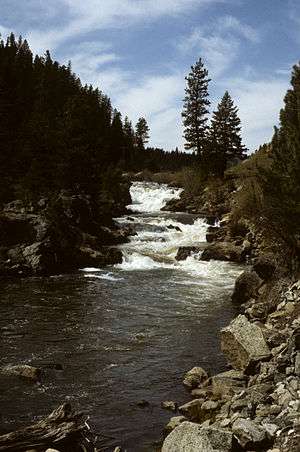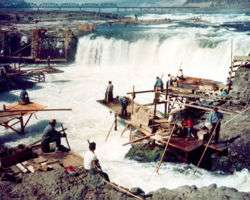Little Salmon River
The Little Salmon River is a tributary of the Salmon River in the U.S. state of Idaho.[1] The river is some 51 miles (82 km) long and drains 576 square miles (1,490 km2) of land.[2]
| Little Salmon River | |
|---|---|
 A waterfall on the Little Salmon River | |
 Location of the mouth of the Little Salmon River in Idaho  Little Salmon River (the United States) | |
| Location | |
| Country | United States |
| State | Idaho |
| Region | Idaho County, Adams County |
| City | New Meadows |
| Physical characteristics | |
| Source | Blue Bunch Ridge |
| • location | Sawtooth Range, Adams County |
| • coordinates | 44°50′28″N 116°15′46″W |
| • elevation | 6,280 ft (1,910 m) |
| Mouth | Salmon River |
• location | Riggins, Idaho County |
• coordinates | 45°25′00″N 116°18′53″W |
• elevation | 1,716 ft (523 m) |
| Length | 51 mi (82 km), South-North |
| Basin size | 576 sq mi (1,490 km2) |
| Discharge | |
| • average | 731 cu ft/s (20.7 m3/s) |
| • maximum | 12,600 cu ft/s (360 m3/s) |
| Basin features | |
| River system | Salmon River |
| Tributaries | |
| • left | Rapid River |
| • right | Goose Creek |
Course
It rises at 6,280 feet (1,910 m) in elevation on Blue Bunch Ridge in the Sawtooth Range of south-central Idaho, close to Payette Lake. From there, it flows north, through the broad Meadows Valley past Meadows and New Meadows, where it receives Goose Creek from the right and Mud Creek from the left.[3]
The river then enters a canyon, cutting across the western edge of the Salmon River Mountains, forming the boundary between Idaho County and Adams County and also running next to U.S. Highway 95. It receives Hazard Creek and Payette Creek both from the right, then receives Boulder Creek, the Rapid River and Squaw Creek from the left, and past Pollock, before joining the Salmon River at the town of Riggins, at 1,720 feet (520 m) above sea level.[1][3]
Geology and land use
The Little Salmon River formed as a result of a rift valley developing between the Rocky Mountains and the Columbia Plateau section of the Intermontane Plateaus. Columbia River basalts underlie much of the western and central parts of the watershed, while other types of volcanic rock of closer origin form the foundations of the eastern mountains. The entire watershed is dissected by fault-block rifting. The water table is high and soils are generally well drained and of volcanic origin.[3]
The upper section of the watershed is a broad and low-gradient, sediment-floored valley used primarily for agriculture and ranching activities, and also has most of the basin's population. The rest of the river flows in a wild, deep, and narrow canyon mostly undeveloped with the exception of the highway. Logging has also been a past activity in the valley, and tourism and fishing are growing industries.[3] In a rare occurrence with rivers, the Little Salmon starts out in a developed, relatively flat area and flows through mountains further downstream, bearing some resemblance to the Klamath River, which also begins in an agricultural valley before cutting through mountains to the sea.
History
Historically, the Nez Perce, Shoshone and Bannock Native American tribes inhabited the watershed of the Little Salmon River. Their lifestyle depended on the river for salmon and on the surrounding lands for other animals, as well as precious natural minerals and resources that provided them with items to trade. Europeans introduced horses to the Bannock, who in turn spread their use to the Shoshones, allowing them to travel further and hunt buffalo and other big game. Settlers began arriving in the 1850s and established farms, ranches and towns. Communications to the outside world was limited until the construction of roads and railroads in the early 20th century. Despite that, the region has still remained relatively isolated.[3]
The Payette National Forest and Nez Perce National Forest cover portions of the Little Salmon River watershed, but at no point does the river flow over federally protected lands. However, the river is also completely free flowing and unobstructed by dams or dikes. Most of the watershed receives about 20 to 25 inches (510 to 640 mm) of rainfall per year. On higher mountain slopes rainfall can be up to 40 to 50 inches (1,000 to 1,300 mm) annually, and on the highest west-facing mountains, precipitation can be much higher than that.[3] About half of the river is inhabited by namesake salmon, but at river mile 24.7 (river kilometer 39.8) Little Salmon Falls, at the confluence with Round Valley Creek, marks the end of the limit for anadromous fish. However, this barrier may have been different at some point in the past, because Native Americans have traditionally fished on the Little Salmon well upriver of the falls. Other than salmon, steelhead, Pacific lamprey, several different species of trout and dace, and other species of fish, are also present. Cottonwood, willow, dogwood and alder grow along the banks of the river.[3]
Hydrology
Irrigation is now the primary water use in the Little Salmon River watershed. Although irrigated farmland lies all along the river, most of it is in the Meadows Valley and also in the watershed of Round Valley Creek, a major western tributary. There are 18,500 acres (75 km2) of irrigated farmland in the Meadows Valley and the Round Valley Creek area, and 700 acres (2.8 km2) closer to the mouth of the river. Although no dams have been built on the river, there are three dams in the headwaters of Goose Creek, a major tributary of the river, to regulate flows for irrigation water. The total water usage for irrigation is 74,800 acre feet (92,300,000 m3) per year.[3]
See also
References
- "Little Salmon River". Geographic Names Information System. United States Geological Survey. 1979-06-21. Retrieved 2010-01-19.
- "USGS Gage #13316500 on the Little Salmon River near Riggins (Average Streamflow)". National Water Information System. U.S. Geological Survey. Retrieved 2010-01-19.
- "Subbasin Assessment—Watershed Characterization" (PDF). Little Salmon River Subbasin Assessment and TMDL. Idaho Department of Environmental Quality. February 2006. Archived from the original (PDF) on 2009-10-02. Retrieved 2010-01-19.
- "USGS Gage #13316500 on the Little Salmon River near Riggins (Peak Streamflow)". National Water Information System. U.S. Geological Survey. Retrieved 2010-01-19.
